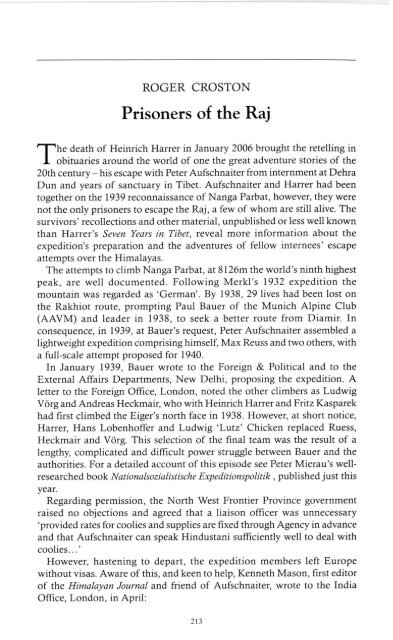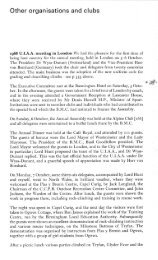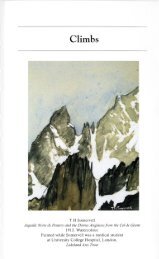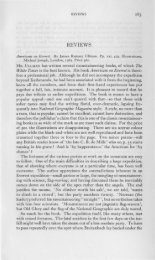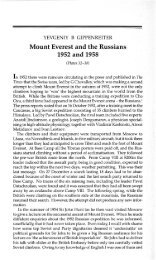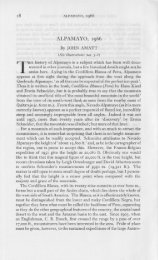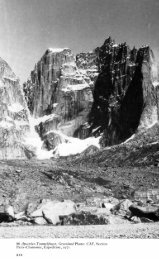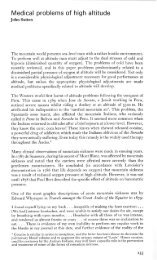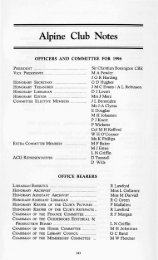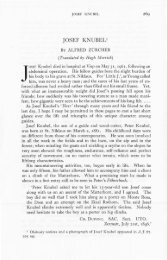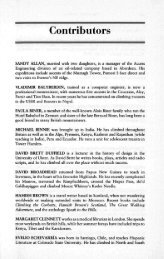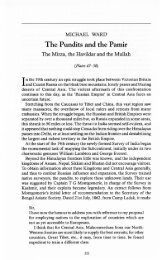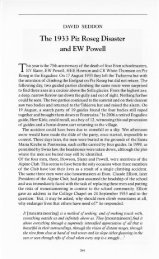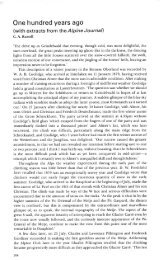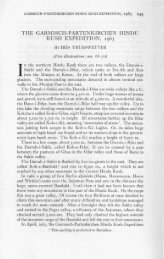History - Alpine Journal
History - Alpine Journal
History - Alpine Journal
You also want an ePaper? Increase the reach of your titles
YUMPU automatically turns print PDFs into web optimized ePapers that Google loves.
ROGER CROSTON<br />
Prisoners of the Raj<br />
The death of Heinrich Harrer in January 2006 brought the retelling in<br />
obituaries around the world of one the great adventure stories of the<br />
20th century - his escape with Peter Aufschnaiter from internment at Dehra<br />
Dun and years of sanctuary in Tibet. Aufschnaiter and Harrer had been<br />
together on the 1939 reconnaissance of Nanga Parbat, however, they were<br />
not the only prisoners to escape the Raj, a few of whom are still alive. The<br />
survivors' recollections and other material, unpublished or less well known<br />
than Harrer's Seven Years in Tibet, reveal more information about the<br />
expedition's preparation and the adventures of fellow internees' escape<br />
attempts over the Himalayas.<br />
The attempts to climb Nanga Parbat, at 8126m the world's ninth highest<br />
peak, are well documented. Following Merkl's 1932 expedition the<br />
mountain was regarded as 'German'. By 1938, 29 lives had been lost on<br />
the Rakhiot route, prompting Paul Bauer of the Munich <strong>Alpine</strong> Club<br />
(AAVM) and leader in 1938, to seek a better route from Diamir. In<br />
consequence, in 1939, at Bauer's request, Peter Aufschnaiter assembled a<br />
lightweight expedition comprising himself, Max Reuss and two others, with<br />
a full-scale attempt proposed for 1940.<br />
In January 1939, Bauer wrote to the Foreign & Political and to the<br />
External Affairs Departments, New Delhi, proposing the expedition. A<br />
letter to the Foreign Office, London, noted the other climbers as Ludwig<br />
Vbrg and Andreas Heckmair, who with Heinrich Harrer and Fritz Kasparek<br />
had first climbed the Eiger's north face in 1938. However, at short notice,<br />
Harrer, Hans Lobenhoffer and Ludwig 'Lutz' Chicken replaced Ruess,<br />
Heckmair and Vbrg. This selection of the final team was the result of a<br />
lengthy, complicated and difficult power struggle between Bauer and the<br />
authorities. For a detailed account of this episode see Peter Mierau's wellresearched<br />
book Nationalsozialistische Expeditionspolitik , published just this<br />
year.<br />
Regarding permission, the North West Frontier Province government<br />
raised no objections and agreed that a liaison officer was unnecessary<br />
'provided rates for coolies and supplies are fixed through Agency in advance<br />
and that Aufschnaiter can speak Hindustani sufficiently well to deal with<br />
coolies... '<br />
However, hastening to depart, the expedition members left Europe<br />
without visas. Aware of this, and keen to help, Kenneth Mason, first editor<br />
of the Himalayan <strong>Journal</strong> and friend of Aufschnaiter, wrote to the India<br />
Office, London, in April:<br />
213


